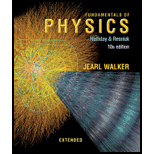
Concept explainers
Figure 5-45 shows a 5.00 kg block being pulled along a friction- less floor by a cord that applies a force of constant magnitude 20.0 N but with an angle θ(t) that varies with time. When angle θ = 25.0°, at what rate is the acceleration of the block changing if (a) θ(t) = (2.00 × 10−2 deg/s)t and (b) θ(t) = −(2.00 × 10−2 deg/s)t? (Hint: The angle should be in radians.)
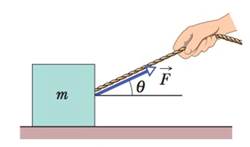
Figure 5-45
Want to see the full answer?
Check out a sample textbook solution
Chapter 5 Solutions
Fundamentals of Physics Extended
Additional Science Textbook Solutions
The Cosmic Perspective
Physics for Scientists and Engineers: A Strategic Approach, Vol. 1 (Chs 1-21) (4th Edition)
Conceptual Physical Science (6th Edition)
College Physics: A Strategic Approach (4th Edition)
Physics for Scientists and Engineers: A Strategic Approach with Modern Physics (4th Edition)
College Physics: A Strategic Approach (3rd Edition)
- A block of mass 4.6 kg is sliding down a ramp with an initial speed of 1.5 m/s. The ramp is inclined from the horizontal by an angle theta = 34.9 degrees and the coefficient of kinetic friction is uk = 0.73. What is the magnitude of the displacement of the block along the ramp from the initial time until it stops?arrow_forwardThe figure shows an overhead view of a 0.026 kg lemon half and two of the three horizontal forces that act on it as it is on a frictionless table. Force F has a magnitude of 3N and is at 8, -31. Force F2 has a magnitude of 10 N and is at 02 = 33". In unit-vector notation, what is the third force if the lemon half (a) is stationary, (b) has the constant velocity V= (131- 14) m/s, and (c) has the V = (12i – 14i) m/s², where t is time? %3D %3D jUnits (a) Number i i+ jUnits (b) Number (c) Number i+ jUnitsarrow_forwardA block of mass m = 10.5 kg rests on an inclined plane with a coefficient of static friction of µ, = 0.11 between the block and the plane. The inclined plane is L = 6.9 m long and it has a height of h = 3.3 m at its tallest point. Write an expression, in terms of 0, the mass m, the coefficient of static friction u, and the gravitational constant g, for the magnitude of the force due to static friction, F, just before the block begins to slide. Will the block slide?arrow_forward
- (a) You want to design a circular racetrack of radius R such that cars of mass M can go around the track at speed w without the aid of friction or other forces other than the perpendicular contact force from the track surface. Find an expression for the required banking angle θ of the track, measured from the horizontal. Your answer should be expressed in terms of M, R, w, and g. (b) Suppose the racecars actually round the track at a speed v > w. What additional radial force is required to keep the cars on the track at this speed? Express your answer in terms of M, R, w, v, and g.arrow_forwardThe figure shows a container of mass m = 2.3 kg connected to a block of mass m2 by a cord looped around a frictionless pulley. The cord and pulley have negligible mass. When the container is released from rest, it accelerates at 0.77 m/s2 across the horizontal frictionless surface. What are (a) the tension in the cord and (b) mass m2? (a) Number i Units (b) Number Units >arrow_forwardA mass m slides up an incline (with = 32.1 degrees above the horizontal) until it stops momentarily because of friction. The coefficient of static friction between the mass and incline is 0.9; the coefficient of kinetic friction between the mass and incline is 0.4. At a given instant, the mass is moving with speed of 4.3 m/s up the incline. How far beyond this point along the incline will the mass move before it comes to a stop?arrow_forward
- A force F of magnitude 665 N lies in the line of action AB = 3i - 1j + 1.6k. What is the magnitude of the y-component of the force?arrow_forwardA particle moving in the xy plane follows a path described as a function of time by i(t) = (3.4 m/s)tî - (2.8 m/s?)tj. A constant force given by F = (5.0î - 2.0j) N acts on the particle (note that other forces must act on the particle as well if it follows the path given above). (a) Determine the displacement of the particle during the interval t = 1.0 s to t = 4.0 s. AT = îm - m (b) Calculate the work done by F during this interval. W =arrow_forwardA block of mass M2 = 8.45 kg on a frictionless plane inclined moving down at angleθ2 = 50° is connected by a cord over a massless, frictionless pulley to a second block of mass M1= 5.36 kg on a horizontal surface. The coefficient of kinetic friction between M1 and the surfaceis μk = 0.15, and the Force F = 11.3 N is acting on M1 at angle θ1 = 30° to the horizontal. (a)draw a free body diagram for each block in the system. (b) What is the acceleration for M1? (c)What is the tension in the cord? (d) After M2moves 10 cm, what is the velocity of M1? (Thesystem was initially at rest)arrow_forward
- A man is pushing a box across an inclined plane with an angle of inclination of 60 degrees away from the horizontal. The box has a mass of 20kg and is moving at a constant speed. The force applied by the person has a magnitude of 250N and the surface of the inclined plane is not frictionless. m> 20 kg Go°arrow_forwardA block slides with constant velocity down an inclined plane that has slope angle 0 = 20.0 °. The block is then projected up the same plane with an initial speed vo = 2.10 m/s. (a) How far up the plane will it move before coming to rest? (b) After the block comes to rest, will it slide down the plane again ("yes" or "no")? Give an argument to back your answer. (a) Number i Units (b)arrow_forwardA wedge with mass M rests on a frictionless horizontal tabletop. A block with mass m is placed on the wedge and a horizontal force F~ is applied to the wedge. There is no friction between the block and the wedge. For α = π/7, what must the magnitude of F~ be if the block is to remain at a constant height above the tabletop? (g is the magnitude of the gravitational acceleration. Take m = 1 kg, M = 5 kg and g = 10 m/s 2) (a) 29 N (b) 35 N (c) 44 N (d) 60 N (e) 104 Narrow_forward
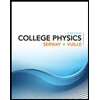 College PhysicsPhysicsISBN:9781305952300Author:Raymond A. Serway, Chris VuillePublisher:Cengage Learning
College PhysicsPhysicsISBN:9781305952300Author:Raymond A. Serway, Chris VuillePublisher:Cengage Learning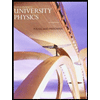 University Physics (14th Edition)PhysicsISBN:9780133969290Author:Hugh D. Young, Roger A. FreedmanPublisher:PEARSON
University Physics (14th Edition)PhysicsISBN:9780133969290Author:Hugh D. Young, Roger A. FreedmanPublisher:PEARSON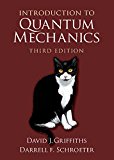 Introduction To Quantum MechanicsPhysicsISBN:9781107189638Author:Griffiths, David J., Schroeter, Darrell F.Publisher:Cambridge University Press
Introduction To Quantum MechanicsPhysicsISBN:9781107189638Author:Griffiths, David J., Schroeter, Darrell F.Publisher:Cambridge University Press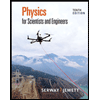 Physics for Scientists and EngineersPhysicsISBN:9781337553278Author:Raymond A. Serway, John W. JewettPublisher:Cengage Learning
Physics for Scientists and EngineersPhysicsISBN:9781337553278Author:Raymond A. Serway, John W. JewettPublisher:Cengage Learning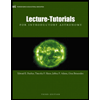 Lecture- Tutorials for Introductory AstronomyPhysicsISBN:9780321820464Author:Edward E. Prather, Tim P. Slater, Jeff P. Adams, Gina BrissendenPublisher:Addison-Wesley
Lecture- Tutorials for Introductory AstronomyPhysicsISBN:9780321820464Author:Edward E. Prather, Tim P. Slater, Jeff P. Adams, Gina BrissendenPublisher:Addison-Wesley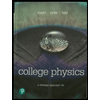 College Physics: A Strategic Approach (4th Editio...PhysicsISBN:9780134609034Author:Randall D. Knight (Professor Emeritus), Brian Jones, Stuart FieldPublisher:PEARSON
College Physics: A Strategic Approach (4th Editio...PhysicsISBN:9780134609034Author:Randall D. Knight (Professor Emeritus), Brian Jones, Stuart FieldPublisher:PEARSON





